Enthronement 19 September 1973 Predecessor Gustaf VI Adolf | Name Carl Gustaf Role King of Sweden | |
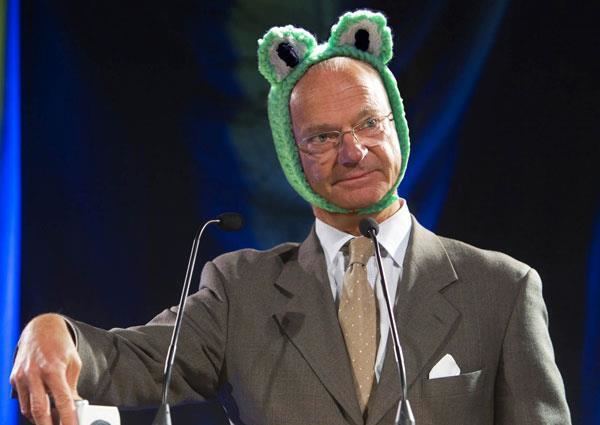 | ||
Reign 15 September 1973 – present Heir apparent Crown Princess Victoria Prime Ministers See list
Olof Palme
Thorbjorn Falldin
Ola Ullsten
Thorbjorn Falldin
Olof Palme
Ingvar Carlsson
Carl Bildt
Ingvar Carlsson
Goran Persson
Fredrik Reinfeldt
Stefan Lofven Born 30 April 1946 (age 79)
Solna, Sweden ( 1946-04-30 ) Issue
Detail Crown Princess Victoria
Prince Carl Philip
Princess Madeleine Spouse Queen Silvia of Sweden (m. 1976) Children Victoria, Crown Princess of Sweden Parents Prince Gustaf Adolf, Duke of Vasterbotten, Princess Sibylla of Saxe-Coburg and Gotha Grandchildren Princess Leonore, Duchess of Gotland Siblings Princess Birgitta of Sweden Similar People Queen Silvia of Sweden, Victoria - Crown Princess, Prince Carl Philip - Duke of V, Princess Madeleine - Duchess, Prince Daniel - Duke of V | ||
A toast to the King of Sweden: Nobel Banquet 2015
Carl XVI Gustaf (full name: Carl Gustaf Folke Hubertus, born 30 April 1946) is the King of Sweden. He ascended the throne on the death of his grandfather, King Gustaf VI Adolf on 15 September 1973.
Contents
- A toast to the King of Sweden Nobel Banquet 2015
- Early life
- Youth and education
- Reign
- Personal interests
- Scouting
- Use of remaining power
- Marriage and family
- Title and styles
- Regnal name
- Arms
- National honours
- Foreign honours
- Foreign
- Honorary military positions
- References
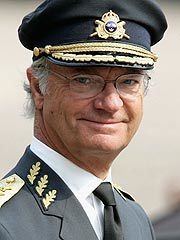
He is the youngest child and only son of Prince Gustaf Adolf, Duke of Västerbotten, and Princess Sibylla of Saxe-Coburg and Gotha. His father died on 26 January 1947 in an airplane crash in Denmark when Carl Gustaf was nine months old. Upon his father's death, he became second in line to the throne, after his grandfather, Gustaf VI Adolf. Following the death of Gustav V in 1950, Gustaf Adolf ascended the throne and thus Carl Gustaf became Sweden's new crown prince and heir-apparent to the throne at the age of 4.
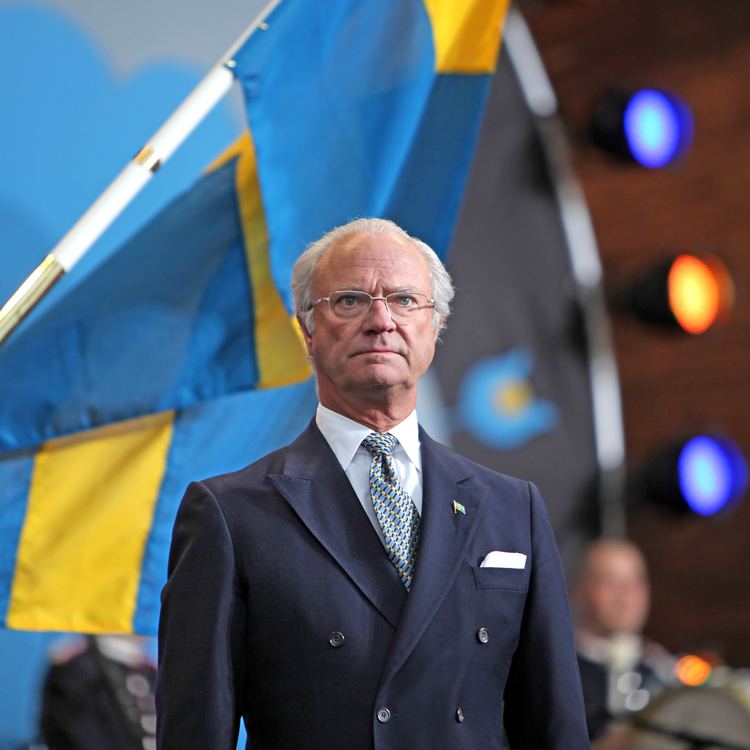
A short while after he became King in 1973, the new 1974 Instrument of Government took effect, formally stripping him of any formal role in the legislative process, and several other duties normally accorded to a head of state, such as the formal appointment of the prime minister, signing off legislation, and being commander-in-chief of the nation's military. The new instrument explicitly limits the king to ceremonial functions and, among other things, to be regularly informed of affairs of state. As head of the Royal House of Bernadotte Carl Gustaf has also been able to make a number of government supported decisions about the titles and positions of its members.
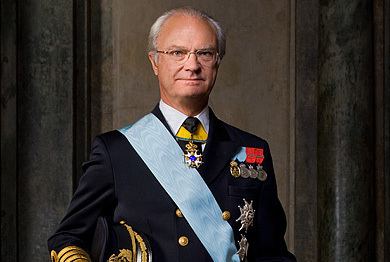
The King's heir apparent, upon passage on 1 January 1980 of a new law establishing absolute primogeniture (the first such law passed in European history), is Crown Princess Victoria, the eldest child of the King and his wife, Queen Silvia.

Carl Gustaf is the 2nd longest-reigning monarch in Swedish history, having overtaken King Gustaf V in 2016 and then reigning for a total of 44 years.
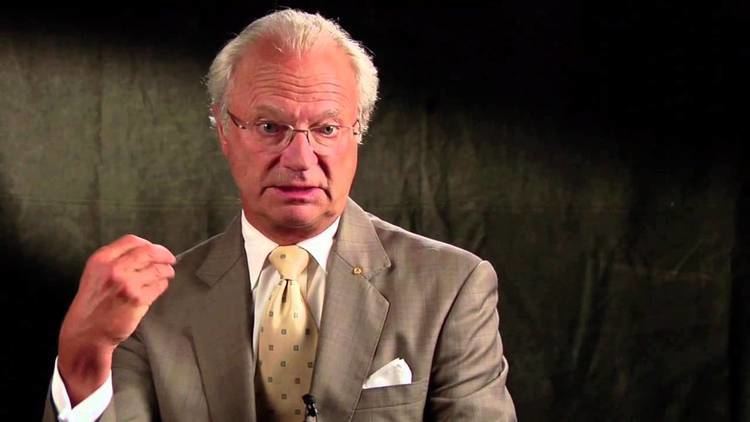
Early life
Carl Gustaf was born on 30 April 1946 at 10:20 in Haga Palace in Solna, Stockholm County. He was the youngest of five children and the only son of Sweden's Prince Gustaf Adolf and Princess Sibylla. He was christened at the Royal Chapel on 7 June 1946 by the Archbishop of Uppsala, Erling Eidem.
He was baptised in Charles XI's baptismal font, which stood on Gustav III's carpet and he lay in Charles XI's cradle with Oscar II's crown beside him. The same christening gown in white linen batiste which the prince carried had been worn by his father in 1906 and would later be worn by his three children. His godparents were the Crown Prince and Crown Princess of Denmark (his paternal uncle and aunt), the Crown Prince of Norway, Princess Juliana of the Netherlands, the King of Sweden (his patrilineal great-grandfather), the Hereditary Prince of Saxe-Coburg and Gotha (his maternal uncle), the Crown Prince and Crown Princess of Sweden (his paternal grandfather and step-grandmother), and Count Folke and Countess Maria Bernadotte af Wisborg.
Prince Carl Gustaf was also given the title of the Duke of Jämtland. His father, Prince Gustaf Adolf, Duke of Västerbotten was killed in an airplane crash on 26 January 1947, at Copenhagen Airport. His father's death had left the nine-month-old prince second in line for the throne, behind his grandfather, then Crown Prince Gustaf Adolf. When his great-grandfather Gustaf V died in 1950, the four-year-old prince became the heir apparent of Sweden.
Carl Gustaf was seven years old before he was told about his father's death, and he expressed his feelings about growing up without knowing his father in a speech in 2005.
Youth and education
After graduating from high school, Carl Gustaf completed two and a half years of education in the Royal Swedish Army, the Royal Swedish Navy, and the Royal Swedish Air Force. He received his commission as an officer in all three services in 1968, and he eventually rose to the rank of captain (in the army and air force) and lieutenant (in the navy), before he ascended to the throne. He has also completed his academic studies in history, sociology, political science, tax law, and economics at Uppsala University and Stockholm University.
To prepare for his role as the head of state, Crown Prince Carl Gustaf followed a broad program of studies on the court system, social organizations and institutions, trade unions, and employers' associations. In addition, he closely studied the affairs of the Riksdag, Government, and Ministry for Foreign Affairs. The Crown Prince also spent time at the Swedish Mission to the United Nations and the Swedish International Development Cooperation Agency (SIDA), worked at a bank in London, at the Swedish Embassy in London, at the Swedish Chamber of Commerce in France, and at the Alfa Laval Company factory in France.
Reign
On 15 September 1973, Carl Gustaf became King of Sweden upon the death of his grandfather, Gustaf VI Adolf. On September 19, he took the required regal assurance (Swedish: Konungaförsäkran) during an extraordinary meeting of the cabinet. Afterwards, he appeared before the parliament, diplomatic corps, court, etc. in the Hall of State at the Royal Palace where he gave a speech. Both the cabinet meeting and ceremony at the Hall were broadcast live on television. Following the ceremonies, he appeared on the balcony to acknowledge gathered crowds. At the cabinet meeting, the King declared that his name would be Carl XVI Gustaf and that his title would be King of Sweden. He adopted, "For Sweden – With the times" as his personal motto. (För Sverige – i tiden).
The Regal Assurance taken by His Majesty King Carl XVI Gustaf on 19 September 1973, Administered by Mr. Lennart Geijer, Councillor of State and Minister of Justice:
"We, Carl Gustaf, King of Sweden, make it known: that since it has pleased the Highest God call to Him on High the former Mighty-powerful, Highborn Prince and Lord, Gustaf VI Adolf, King of the Swedes, the Goths and the Wends, and We, according to and by the power of the Act of Succession established and ascertained by the Estates of the Realm on 26 September 1810, succeeding the aforementioned Exalted Lord have ascended to the Royal Swedish Throne.
In so doing We hereby affirm, and that with the greatest emphasis, that We desire to, and shall, govern the Realm according to the literal requirement of the Form of Government, for their compliance ascertained and adopted jointly on 6 June 1809 by the King and the Estates of the Realm, as well as by any other legitimate constitutional law of the Realm, public law and legal ordinance.
We shall also, according to the aforementioned Form of Government and laws, seek by our utmost capability, as a righteous King and gracious father to the Swedish people, and by a legal, fair and mild rule, and so that We might defend that rule with a clear conscience before God on High, further the veritable progress and good of the realm and every resident, all of which being what We of free will and mature deliberation have decided, We thus confirm by the signing of Our name in Our own hand and with this vibrant oath, that we such shall obey and execute.
When Carl Gustaf ascended the throne, plans were already in place to replace the 1809 Instrument of Government which gave the King de jure political authority in government. Though the King was a near-autocrat on paper, the Riksdag's authority grew steadily into the early 20th century. In 1914, Gustaf V made a speech which resulted in what is known as the Courtyard Crisis wherein he was accused of interfering with politics. With the principle of parliamentary democracy formally established since 1917, the king's actual direct involvement in government lessened and the powers assigned to him were increasingly done by ministers in his name.
The new 1974 Instrument of Government first took effect in Carl Gustaf's reign and formally stripped the new king of his remaining powers such as appointing the prime minister and his position as commander-in-chief of the military. He is thus second only to the Emperor of Japan in his lack of even nominal constitutional authority. The head of state's duties are, according to the new constitution, explicitly only of a representative and ceremonial nature. The 1974 document stripped the king of most of his formal political powers while retaining him as head of state, thus codifying actual practices dating from the definitive establishment of parliamentary government in 1917. Previously, the King formally appointed the Prime Minister, though in practice he was almost always the leader of the majority party or coalition in the Riksdag. Since the adoption of the current Instrument, that prerogative is now exercised by the Speaker of the Riksdag on the behalf of the Riksdag. Additionally, bills passed by the Riksdag do not need his signature to become law.
He is the foremost representative of Sweden and pays State Visits abroad and receives those to Sweden, he opens the annual session of the Riksdag, chairs the Special Council held during a change of Government, holds regular Information Councils with the Prime Minister and the Cabinet, chairs the meetings of the Foreign Affairs Council, and receives Letters of Credence of foreign ambassadors to Sweden and signs those of Sweden to foreign nations. As this type of figurehead, he also voluntarily abstains from voting in Swedish elections.
King Carl Gustaf holds the highest ranks in the three branches of the Swedish Armed Forces; this is due to the fact that he was, as stipulated by the 1809 Instrument of Government in effect at the time of his accession to the throne in 1973, the Supreme Commander of the Swedish Armed Forces (§ 14) and therefore he was promoted ex officio from his earlier ranks of captain and lieutenant, to general and admiral. Under the provisions of the Instrument of Government of 1974, which became effective on 1 January 1975, King Carl Gustav no longer holds this constitutionally-mandated position of Supreme Commander, but he kept his ranks à la suite since he no longer has any military command authority, except over his military staff at his court.
Worldwide, Carl XVI Gustaf is probably best known as the presenter of the Nobel Prizes each year, the first Nobel laureate who received the prize from his hands was Leo Esaki. He also hands over the Polar Music Prize. The King holds honorary doctoral degrees from the Swedish University of Agricultural Sciences, the Royal Institute of Technology, the Stockholm School of Economics and from the Åbo Akademi University in Finland.
Personal interests
The King is passionate about the environment, technology, agriculture, trade, and industry. Like many members of the Swedish royal family, the King has a keen interest in automobiles. He owns several Porsche 911s – a car model which is said to be a particular favourite of the King – as well as a vintage Volvo PV444, a Ferrari 456M GT, an authentic AC Cobra and other cars. The first pictures taken of him and his future wife were of them sitting in his Porsche 911. In the summer of 2005 he was involved in a traffic accident in Norrköping. The accident was described as a "fender bender", with no serious personal injuries claimed. Nevertheless, the incident caused national headlines.
Scouting
The King is the honorary chairman of the World Scout Foundation, and often participates in Scout activities both in Sweden and abroad. He regularly visits World Scout Jamborees, for instance the 1979 Dalajamb World Jamboree International Encampment hosted by Sweden, the 2002 World Jamboree held in Sattahip, Thailand, and the 100th Anniversary of World Scouting 2007 World Jamboree held in Hylands Park, England. He also attended the 1981 National Scout Jamboree in Virginia, United States, and was awarded the Bronze Wolf, the only distinction of the World Organization of the Scout Movement, awarded by the World Scout Committee for exceptional services to world Scouting, in 1982. He also attended the 22nd World Scout Jamboree. He gave a speech on 6 August 2011 at the closing ceremony with more than 40,000 people watching. The band Europe also performed for him singing "The Final Countdown". King Carl Gustaf made an appearance at the 2013 Boy Scouts of America National Jamboree in West Virginia. Together with King Abdullah of Saudi Arabia, King Carl Gustaf has supported the Messengers of Peace programme.
Use of remaining power
So empowered as head of his house, and with the support and authorization of the Swedish government, King Carl Gustaf since he was enthroned in 1973 has made a number of personal decisions regarding the titles and positions of relatives and family members, including the demotion of a sister, elevation of several commoners to royalty, rebuff of an elderly uncle’s wishes and the creation of new Swedish titles and duchies.
Marriage and family
The King married Silvia Sommerlath, whose father was German and whose mother was Brazilian, and who had grown up in both countries. They met at the 1972 Summer Olympics in Munich, where she was an interpreter and host. The wedding was held on 19 June 1976 at Stockholm Cathedral and the ceremony was performed by the Archbishop of Uppsala, Olof Sundby. The wedding was preceded, the evening before, by a Royal Variety Performance, where the Swedish musical group ABBA performed "Dancing Queen" for the very first time, as a tribute to Sweden's future queen. The King and his family moved to Drottningholm Palace west of Stockholm in 1980. He and the Queen have maintained their business offices at the Royal Palace of Stockholm.
King Carl Gustaf and Queen Silvia have three children and six grandchildren:
Prince Carl Philip was born the heir apparent. However, a constitutional reform, which was already under way at the time of his birth, made his elder sister, Victoria, the heir apparent and Crown Princess of Sweden on 1 January 1980, according to the principles of absolute primogeniture, which Sweden was the first recognised monarchy to adopt. King Carl Gustaf objected after the reform, not to the succession by females but to the fact that his son lost the position and title which he had had since birth.
Title and styles
King Gustaf VI Adolf was the last who used the style "By the Grace of God King of the Swedes, the Goths/Geats and the Wends" (med Guds Nåde Sveriges, Götes och Wendes Konung; Latin: Dei Gratia Suecorum, Gothorum et Vandalorum Rex). This traditional title had been in use since the establishment of the hereditary monarchy in 1544. Carl XVI Gustaf instead chose the plain and simple title "King of Sweden" (Sveriges Konung), thereby ending a centuries-old tradition.
Regnal name
In the 16th century, Johannes Magnus construed a mythical line of Swedish kings, beginning with Magog, the son of Japheth, in an attempt to substantiate the antiquity of the Swedish throne. Based on that list, King Charles IX (reigned 1604 to 1611) adopted an ordinal unsupported by reliable historical sources. The only two previous monarchs named Charles (Karl in Swedish) have traditionally been numbered by counting backwards from Charles IX, and subsequent monarchs by counting forward from him. Adhering to that tradition, the current King of Sweden proclaimed himself Carl XVI Gustaf even though he is only the tenth Swedish monarch by the first name.
Arms
On his creation as Duke of Jämtland, Carl XVI Gustaf was granted an achievement of arms which featured the arms of Jämtland in base (these arms can be seen on his stallplate as knight of the Danish Order of the Elephant at Frederiksborg Palace). Since his accession to the throne, he has used the greater coat of arms of Sweden although he is still associated with the ducal title of Jämtland.
